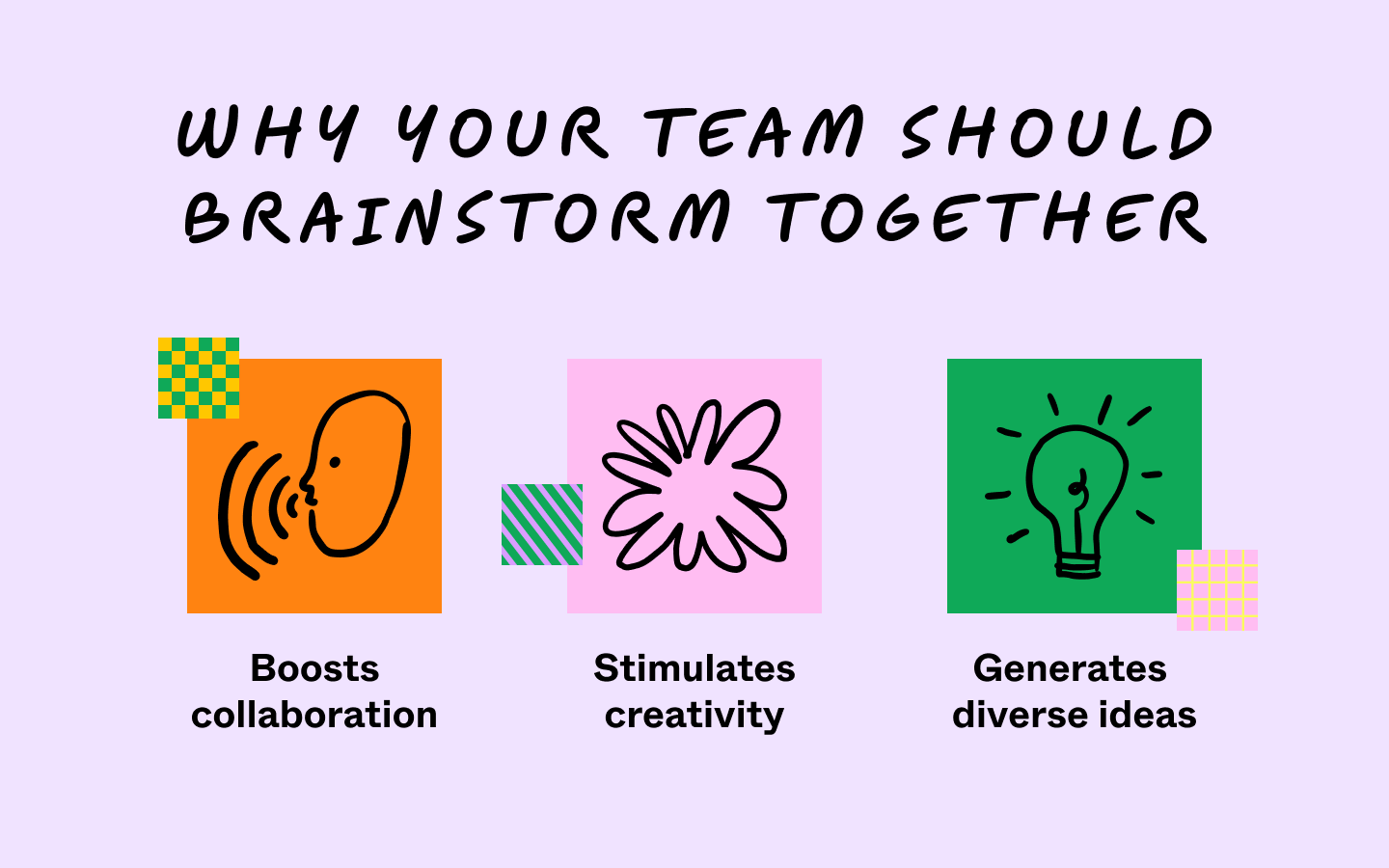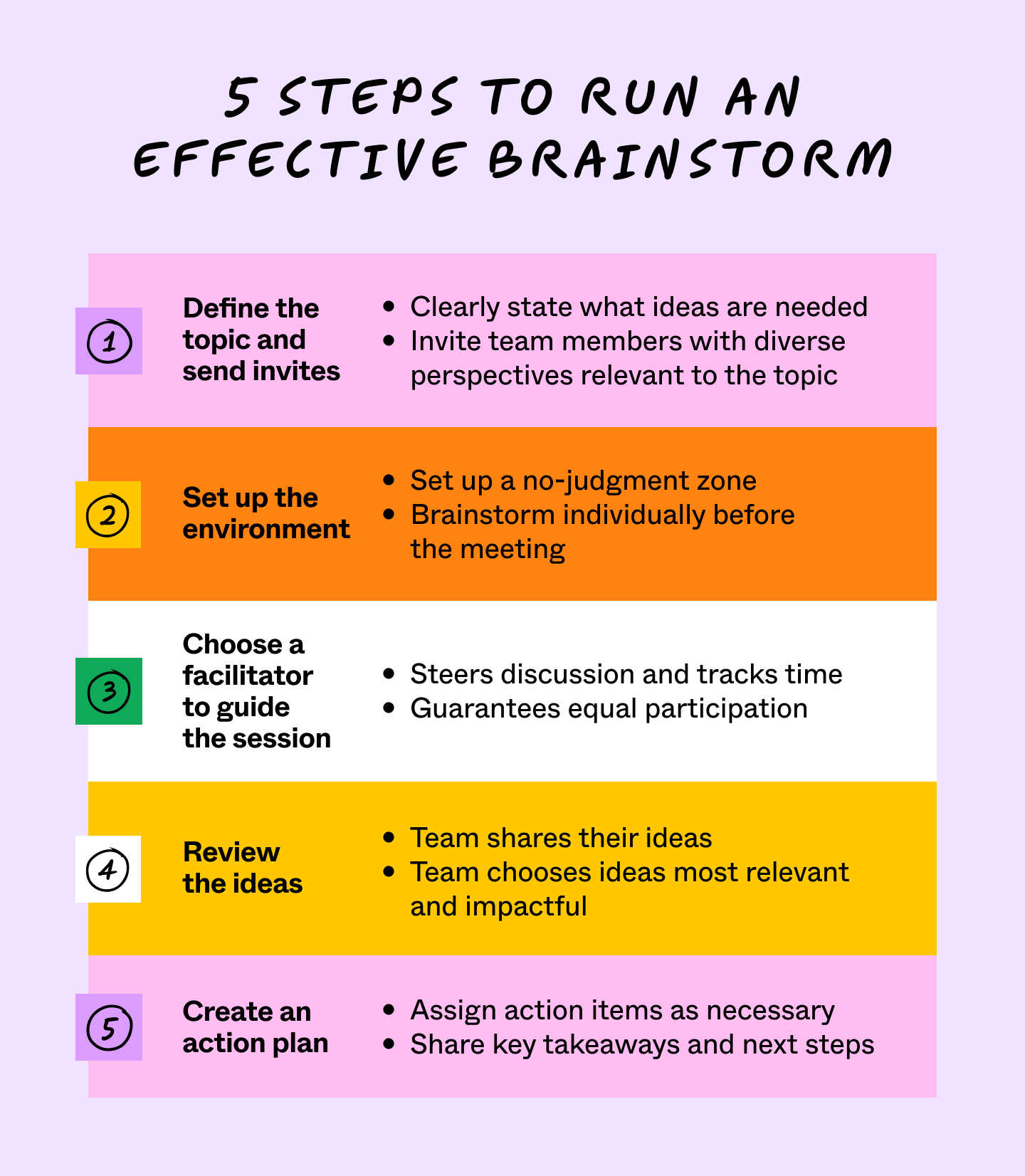What is Brainstorming?

While you might stumble upon design inspiration in solitude, collaboration is key to building a successful product. Brainstorming has been a cornerstone for creatives since before there were fancy digital tools for it—or since before it was called brainstorming.
French salons and design charrettes were early iterations of the modern brainstorm, where groups of people would come together to work through solutions to problems. Today, brainstorming remains fundamental to the design process.
This guide provides a step-by-step walkthrough of brainstorming, covering its definition, significant advantages, various methods, and the process of conducting your own session.
What is brainstorming?
Brainstorming promotes free thinking to generate ideas for a certain problem or topic.
While you can brainstorm alone, the real magic happens when you round up a team. Groups bring diverse ideas to the table, allowing you to build on one another’s concepts and maintain a continuous flow of creative thinking.
In a brainstorming session, participants share creative ideas and insights, and throw possible solutions into the mix. You’ll likely toss out some propositions altogether, but others may guide a project’s first, next, or final step.
3 key benefits of brainstorming
Here are three main benefits of brainstorming with your team.

Boosts collaboration and teamwork
Group brainstorming transforms an individual thinking process into a collective effort, boosting collaboration within your team.
In a brainstorming session, everyone gets a say. Make sure every voice counts and each person’s ideas receive recognition.
Stimulates creative thinking
Brainstorming allows ideas to run wild, resulting in unconventional and innovative ideas you probably wouldn’t think of otherwise.
Promote an open, nonjudgmental environment in your brainstorming session, giving your team permission to explore ideas they might have not gotten a spotlight before.
Generates creative ideas
When teams come together to brainstorm, the mixture of ideas from diverse perspectives yields creative solutions. With more ideas to choose from, you can expedite the decision-making process.
Types of brainstorming
Different brainstorming techniques provide unique ways to generate ideas and solve problems. The type of brainstorming you should use depends on how your team works together, the specific problem, and your desired results.
Check out these seven FigJam templates that can power up your team brainstorm.
Brainwriting
Brainwriting prompts you to write and record as many innovative ideas as possible. Invite a team member to add their input to your idea, continuing this tag-team process until everyone contributes to each idea. Have a facilitator gather and present all the written ideas for an overview.

Use this brainwriting template for a collaborative brainstorming session.
Reverse brainstorming
Instead of generating ideas for solutions, reverse brainstorming generates as many potential causes or factors contributing to the problem as possible. For example, imagine your product struggles with customer retention. You’ll want to:
- Define the problem.
- Identify a flaw in your system, like poor customer service.
- Reverse the idea by turning negatives into desired positives—for example, great customer service.
- Consider ways to achieve the desired positive, like better training for your customer service team.
This technique can help identify issues that might not be immediately obvious.

Use this reverse brainstorming template for a unique way to identify problems and solutions.
5 whys brainstorming
With the 5 whys method, you keep asking “why” until you get to the bottom of a problem. Instead of stopping at the first answer, you find issues lurking beneath the surface. Once you’ve exposed the core problem, you can capture it in a problem statement.
For more information on this brainstorming technique, check out this article on the 5 whys.

Crazy 8
The crazy 8 exercise is a team drawing challenge where everyone helps sketch eight new ideas. No need for perfection or logic—your only goal is to be creative. Sometimes the wildest inspiration hits when you least expect it.

Mind mapping
Mind mapping begins with a main idea in the middle, with branches connecting related ideas. Once you organize your thoughts, it’s easier to break down complex ideas.
For more information on this type of brainstorming, check out this article on how to mind map.

Use this mind mapping template to organize your ideas and break down complex ideas.
Starbursting
Starbursting poses questions to inspire solutions for a problem or topic. For example, if you’re brainstorming a new product, each point on the star might represent a key product question, like:
- Who is my target audience?
- What are the features of the product?
- Where is this product being used?
- Why would my target audience want this product?
- When is the best time to launch this product?
Discuss these five questions, then craft new questions based on your answers.

Use the starbursting diagram template to prompt questions and guide solutions.
Production vision board
A production vision board helps you visualize your strategy, outline goals, and quickly map out product features and user needs. This helps maintain momentum in your brainstorming session without getting bogged down in details.

Use this product vision board template to keep your brainstorming session on task.
How to run a brainstorming session in 5 steps
Ready to run your own brainstorming session? Here’s how to do it in five easy steps.

1. Define the topic and send invites.
Before you start your brainstorm, you need to outline what you’re tackling—the topic or problem. This gives your team an understanding of what kind of ideas you’re after and why they’re involved.
Invite team members who offer diverse perspectives and insights related to the topic at hand. Keep the group size manageable to ensure active participation and a dynamic exchange of ideas.
2. Set up the environment.
Many teams run remote brainstorming sessions, especially since studies of virtual brainstorming show that it can be more effective than in-person brainstorming. Most people feel more at ease sharing ideas behind a screen instead of under the spotlight.
Provide your team with pre-session tasks, like individually brainstorming before the main event. This gets people mulling over the topic or problem and gives you a head start with initial ideas. You’re aiming for quantity here, not perfection. Even half-baked ideas are welcome.
3. Choose a facilitator to guide the session.
For any brainstorming session to run smoothly, a designated facilitator should be there to help guide the discussion, keep track of time, and ensure everyone has a chance to contribute.
Extroverts might dominate, while introverts may shrink away from the limelight. Newbies and junior team members may feel overshadowed by higher-ups. Your facilitator should have the leadership skills necessary to keep everyone engaged.
4. Review the ideas.
Review ideas and spot the big contenders. Which ideas are the most relevant, feasible, and have the largest potential impact?
If team members are reluctant to speak up, consider offering a prize to encourage brainstorming participation. Figma’s Andrea Helmbolt recommends gift cards to a coffee shop, stickers, or selfie sticks to reward those tossing out ideas.
5. Create an action plan.
After selecting your most promising ideas, devise a plan of action. Start by assigning tasks and setting deadlines so everyone understands the expectations.
After the meeting, share a brief recap focusing on key ideas, breakthroughs, and the consensus. Inject excitement by highlighting positive takeaways and revealing exciting possibilities uncovered during the brainstorm.